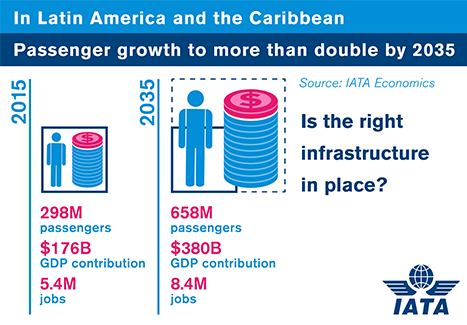Passenger Numbers to Double by 2035
Mexico City, 2016-Nov-18 — /Travel PR News/ — The International Air Transport Association (IATA) urged governments in Latin America and the Caribbean to work with industry to make infrastructure a priority in unlocking aviation’s economic and social benefits.
Passenger demand in Latin America and the Caribbean is expected to more than double from 298 million in 2015 to 658 million in 2035. If that demand is met, the number of jobs supported by aviation in the region will grow from 5.4 million to 8.4 million over the same period. And aviation’s contribution to regional GDP will increase from $176 billion to $380 billion.
“Aviation is the business of freedom. It helps people to trade, to discover and to better their lives. A successful aviation industry generates prosperity. Despite protectionist rhetoric — which we must be robust in countering — economies need air connectivity to grow and integrate with world markets,” said Alexandre de Juniac, IATA’s Director General and CEO during the Latin American and Caribbean Air Transport Association (ALTA) Airline Leadership Forum in Mexico City.
Focusing further on Latin America and the Caribbean, de Juniac noted the many challenges that airlines face. “Operational costs are high. Taxes are significant. In addition, regulations are burdensome and often not aligned with global standards. We need a strong partnership with governments that focuses on unlocking aviation’s benefits to tackle these issues effectively. On top of that, in Latin America there is a huge opportunity for a government-industry partnership to create value by addressing the region’s many infrastructure deficiencies.”
Deficiencies in the air and on the ground
De Juniac urged the region to address two critical infrastructure issues:
- Capacity growth in line with demand: Severe capacity constraints in Bogotá, Lima and Mexico City illustrate the region’s airport capacity crunch. While plans are in place to address these, relief is years away at best. In the meantime, there will be lost opportunities for jobs and economic growth. Bogotá illustrates the importance of consultation with airlines to ensure that solutions match market demand and industry needs without being over-built. And Argentina, which ranks 114 among 141 countries for the quality of its air transport infrastructure (1), needs an urgent overhaul of its antiquated and costly air navigation system.“The key is consultation. Airlines, governments and airport operators need to be partners in building successful cost-efficient infrastructure in line with market realities on cost and capacity,” said de Juniac.
- Infrastructure privatization: De Juniac sounded a cautionary note on airport privatization. “Harnessing the efficiencies of private enterprise to improve infrastructure needs iron-clad regulation to protect the users from out-of-control monopolies,” said de Juniac. He also urged governments to award infrastructure concessions with a priority on finding partners aligned with the long-term national interest of realizing the benefits of growing connectivity—not the short-term gain of those coming with the highest bid.Chile, while in most aspects a model for forward-thinking governments on building a competitive air transport industry, is an example of what can happen when regulation is not strong enough. “Pre-funding airport expansion plans at Santiago’s airport has seen airport charges skyrocket, putting at risk the country’s air transport competitiveness and the social and economic benefits it generates,” said de Juniac.
Download the World Economic Forum’s Travel & Tourism Competitiveness Report 2015 (pdf)
For more information, please contact:
Corporate Communications
Tel: +41 22 770 2967
Email: corpcomms@iata.org
Notes for Editors:
- IATA (International Air Transport Association) represents nearly 265 airlines comprising 83% of global air traffic.
- You can follow us at http://twitter.com/iata2press for news specially catered for the media.
SOURCE: International Air Transport Association (IATA)


